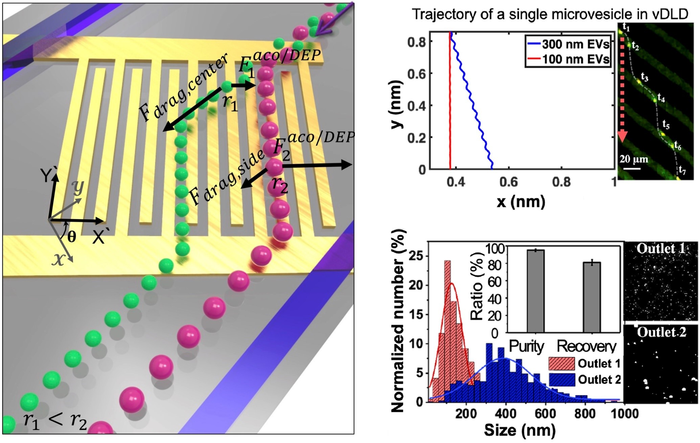Extracellular vesicles (EVs) are nano- and submicron-sized bioparticles formed by the majority of the cells in the human body. They hold biological data such as ribonucleic acid and proteins which can be transported to local and remote cells since they flow through most of the body fluids such as urine and blood.
 Sorting of submicron extracellular vesicles in a combined acoustic and electric force field. Image Credit: SUTD.
Sorting of submicron extracellular vesicles in a combined acoustic and electric force field. Image Credit: SUTD.
Two main subtypes of EVs — exosomes and microvesicles — carry various types of biomolecules from their parental cells because of their diverse biogenesis and secretion origin in the cell.
Owing to their composition and stability, exosomes are priceless markers and carriers for disease diagnosis as well as for transporting medicines throughout the body. But, these exosomes are extremely small — under 200 nm in size, or one-tenth of the size of a PM2.5 dust particle — thus making it difficult to realize an efficient purification and a high throughput.
An exact and scalable sorting technique for nano and submicron-sized EVs would be beneficial to diverse areas such as minimally invasive cancer diagnostics, basic biological research and exosome-based drug delivery.
An interdisciplinary research group headed by Associate Professor Ye Ai from the Singapore University of Technology and Design (SUTD), along with Assistant Professor David Collins from the University of Melbourne, created an innovative hybrid acoustophoresis and dielectrophoresis (DEP) technology for the successful sorting and separation of submicron bioparticles and EVs.
The microfluidic sorting device employed a tilted-angle surface acoustic wave transducer positioned directly inside a microfluidic channel to instantaneously couple acoustic energy and electrical fields into the adjacent fluid domains. This was performed to circumvent the attenuation losses and produce numerous pressure node positions for the lateral displacement of the particles.
The particles in this system moved toward the nodal positions between electrodes because of the acoustic radiation forces while the negative DEP force field concurrently directed them away from the electrodes where the pressure nodes were also situated.
The acoustic/DEP force combination not only shrunk the critical diameter of the separated particles to the exosome size range but also made separation achievable at lower pressure fields and powers compared to the application of these forces separately.
By exploiting this distinctively combined acoustic or DEP force field and tweaking the electrical features of the suspending solution, the researchers could demonstrate a very efficient separation of exosomes (<200 nm) and microvesicles (>300 nm) with more than 95% purity and 81% recovery.
This research signifies a new and beneficial approach for submicron bioparticle manipulation, with possible applications in biomedical research as well as clinical uses.
The sorting of EV subtypes has gained increasing attention because of its extensive impact in various applications across the fields of biology, diagnostics, and medicine. This work demonstrates new capabilities in the label-free precise sorting of submicron EVs, offering the ability to isolate intact, non-aggregated exosomes with a reproducible size range in diverse exosome-based applications.
Associate Professor Ye Ai, Study’s Principal Investigator, Singapore University of Technology and Design
The study has been published in Nano Letters, a top-tier, multidisciplinary journal, spanning a broad range of topics in nano- and microscale experimental and theoretical fields.
The other participants in this research project are SUTD graduate students and postdoctoral fellows, including Mahnoush Tayebi and Dahou Yang. This study received support from the Ministry of Education, Singapore, under its Academic Research Fund Tier 2 grant (MOE-T2EP30120-0017).
Journal Reference:
Tayebi, M., et al. (2021) Deterministic Sorting of Submicrometer Particles and Extracellular Vesicles Using a Combined Electric and Acoustic Field. Nano Letters. doi.org/10.1021/acs.nanolett.1c01827.